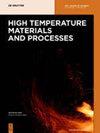T2铜合金双辊铸轧凝固过程的数值与实验研究
IF 1.5
4区 材料科学
Q4 MATERIALS SCIENCE, MULTIDISCIPLINARY
引用次数: 2
摘要
摘要基于CAFE理论和KGT模型,建立了求解T2铜合金在熔池中枝晶生长和凝固的双辊铸带数学模型。分析了铸轧温度、传热等工艺条件对带钢组织的影响机理。结果表明,液态金属形成35 μm的冷却层,该层由大量细小的等轴晶体组成。然后,一些晶粒会出现在新的冷却层附近,并竞争性地向熔池的核心生长。主晶粒主要沿〈001〉取向生长为柱状晶体,其余不定向生长的晶粒逐渐消除。晶粒数量减少,柱状晶粒半径变粗。Kiss点是凝固组织的关键因素,Kiss点的较低位置可能会限制柱状晶体的生长空间,从而细化晶粒。本文章由计算机程序翻译,如有差异,请以英文原文为准。
Numerical and experimental research on solidification of T2 copper alloy during the twin-roll casting
Abstract Based on CAFE theory and KGT model, the twin-roll strip casting mathematical model was established to solve the dendrite growth and solidification of T2 copper alloy in the molten pool. The influence mechanism of casting temperature, heat transfer, and other technological conditions on the microstructure of strip was analyzed. The results showed that the liquid metal formed 35 µm chilling layer after touching the rollers, and the layer was consisted of a high number of small and equiaxed crystals. Then some grains would appear close to the newly chilling layer, and grow toward the core of molten pool competitively. The dominant grains mainly grew along the 〈001〉 orientation into columnar crystals, and the rest grains that grew out of alignment were eliminated gradually. The number of grains declined, and the radius of columnar grains became coarsening. The Kiss point is a key factor for solidification structure, and the lower location of the Kiss point could limit the growth spaces of columnar crystals, which refined the grains.
求助全文
通过发布文献求助,成功后即可免费获取论文全文。
去求助
来源期刊

High Temperature Materials and Processes
工程技术-材料科学:综合
CiteScore
2.50
自引率
0.00%
发文量
42
审稿时长
3.9 months
期刊介绍:
High Temperature Materials and Processes offers an international publication forum for new ideas, insights and results related to high-temperature materials and processes in science and technology. The journal publishes original research papers and short communications addressing topics at the forefront of high-temperature materials research including processing of various materials at high temperatures. Occasionally, reviews of a specific topic are included. The journal also publishes special issues featuring ongoing research programs as well as symposia of high-temperature materials and processes, and other related research activities.
Emphasis is placed on the multi-disciplinary nature of high-temperature materials and processes for various materials in a variety of states. Such a nature of the journal will help readers who wish to become acquainted with related subjects by obtaining information of various aspects of high-temperature materials research. The increasing spread of information on these subjects will also help to shed light on relevant topics of high-temperature materials and processes outside of readers’ own core specialties.
 求助内容:
求助内容: 应助结果提醒方式:
应助结果提醒方式:


